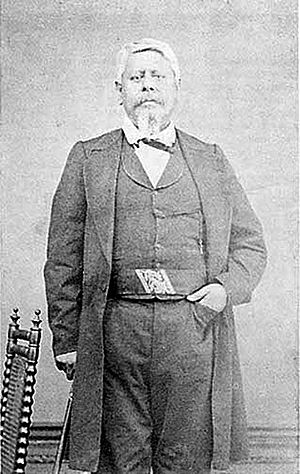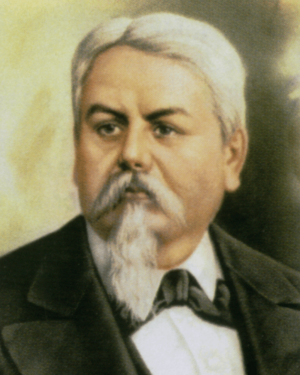Juan N. Méndez facts for kids
Quick facts for kids
Juan Nepomuceno Méndez
|
|
|---|---|
 |
|
| 34th President of Mexico | |
| In office 6 December 1876 – 17 February 1877 |
|
| Preceded by | Porfirio Díaz |
| Succeeded by | Porfirio Díaz |
| Personal details | |
| Born | 2 July 1820 Tetela de Ocampo, Puebla, New Spain |
| Died | 29 November 1894 (aged 74) Mexico City, Mexico |
| Resting place | Panteón de Dolores |
| Nationality | Mexican |
| Political party | Liberal |
| Spouse | Trinidad González y Castruera |
Juan Nepomuceno Méndez Sánchez (born July 2, 1820 – died November 29, 1894) was an important Mexican general and politician. He was a close friend of Porfirio Díaz, who later became a very famous president. Méndez himself served as the interim (temporary) President of Mexico for a few months, from December 6, 1876, to February 17, 1877.
Contents
Life Before Becoming President
Juan Nepomuceno Méndez was born in a place called Tetela de Ocampo in Puebla, Mexico. Before joining the army, he worked in business and with farm animals.
In 1847, when he was 27, he joined the Mexican Army to fight against the United States in the Mexican–American War. After this war, he stayed in the army. On December 15, 1854, he became a commander in the Puebla National Guard. His group supported the Plan de Ayutla in 1854. He also fought in important conflicts like the War of the Reform and the War of the French Intervention. He even fought against Emperor Maximilian.
In January 1856, he defended Puebla from rebels. He also fought against the Conservatives in the mountains of Puebla and Tlaxcala in 1857. That same year, he was promoted to colonel. In 1858, he became the treasurer for the State of Puebla and a leader in the Department of Zacatlán.
He bravely fought in the famous Battle of Puebla against the French on May 5, 1862. He also helped defend the city during the long siege that followed. On July 27, 1863, he was promoted to brigadier general. In the same year, he was named governor and military commander of Puebla.
Later, the French captured him and sent him away from Mexico on January 17, 1866. But he managed to return to the country on July 31, 1866. On August 26, 1866, he became the political leader of the Sierra Norte region. After that, he became the commander-in-chief of all forces in the State of Puebla.
Along with General Sóstenes Rocha, he helped in the siege of Querétaro in 1867. He was again named governor and military commander of Puebla on April 16, 1867. He held these jobs until January 15, 1868.
He also took part in two important revolts: the Plan de la Noria in 1871 and the Plan of Tuxtepec in 1876. These revolts were led by his friend, Porfirio Díaz.
Serving as Interim President
The Plan of Tuxtepec was successful, which meant Porfirio Díaz was in charge. On December 6, 1876, Díaz temporarily gave the government to Méndez. Díaz needed to leave to fight against José María Iglesias, who also claimed to be the rightful president of Mexico.
As the temporary president, Méndez called for new elections. Porfirio Díaz won these elections. Méndez's time as president ended on February 17, 1877, when Díaz returned to lead the country.
Life After the Presidency
After his time as president, Méndez became a member of the Senate in 1877. While in the Senate, he worked to end the military draft, which forced people to join the army. He was a senator until 1880.
He served as governor of Puebla for a third time, from October 1, 1880, to January 31, 1885. On February 3, 1885, he became the president of the Supreme Military Court. He worked there until he passed away in Mexico City in 1894. He did not leave behind any property or money.
Personal Life
Juan Nepomuceno Méndez was married to Trinidad González y Castruera.
See also


